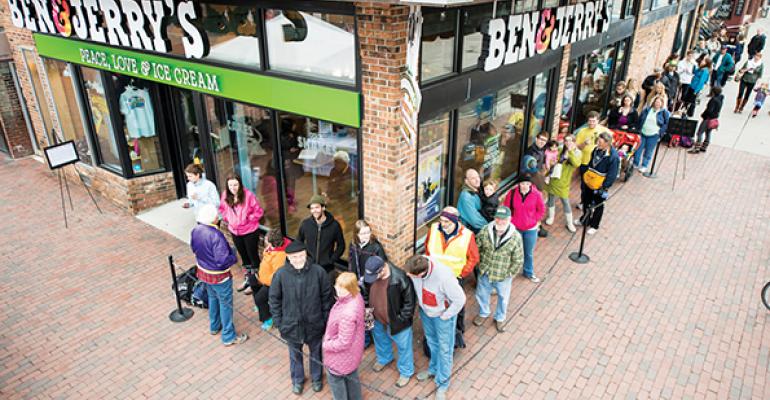Ben Cohen and Jerry Greenfield took a $5 correspondence course on ice cream making and in 1978 used that knowledge to start their first shop in a Burlington, Vt., renovated gas station.
After they rented space in an old spoon and bobbin mill, it was the packaged ice cream the two started selling in 1980 that would make Ben & Jerry’s a nationally known brand with ice cream names like “Cherry Garcia” and “Chubby Hubby.”
But the company’s franchise system remains an important element of that brand and that, too, remains beloved among consumers — enough so that the 579-unit chain received top marks among Limited-Service chains in a highly competitive field.
“We consider it a crucial part of who we are because it brings the Ben & Jerry’s brand to life,” said Eric Thomas, the franchise development manager for the chain. “The shops have remained near and dear to our hearts as we’ve grown.”

The chain was the overall leader among Limited-Service chains, earning top scores in that category in a variety of measures, including Food Quality, Menu Variety and Reputation.
Ben & Jerry’s believes that its success is rooted in training and its location strategy. The company concentrates on building new stores in places where people are walking and enjoying themselves, leisure-time destinations.
“We focus on leisure-time destinations where people are on foot and having a great time, whether they’re dining at restaurants, an upscale boutique style shopping, going to the movies or the theater,” Thomas said. “They’re spending money because they want to, not because they have to.”
The chain is careful in selecting new locations that fit this definition, and build between 10 and 15 locations each year.

“Our growth is focused more on quality over quantity,” he said. “We know that finding those fun, leisure-time destinations is a challenge, and we want to make sure we’re opening in the right spots.” And with the right operators, he said.
The system’s operators generally own two or three locations at a time so they are closer to the customer base.
“We have to feel comfortable with our franchise candidates,” Thomas said. “They have to be passionate believers in Ben & Jerry’s values. It’s a different sort of franchisee who becomes a Ben & Jerry’s franchisee. We’re looking for people who want to own a business that puts smiles on people’s faces.”
He added that the company’s mission and values — which include using sustainable methods to make its ice cream; ensuring the company can manage growth along with an active social mission — fits well with today’s younger consumers.
“Our iconic flavors have served us well over the years,” Thomas said. “But the mission and values really resonates, particularly with younger folks and the Millennial generation. It’s a really nice fit.”
Ben & Jerry’s also focuses heavily on training and development. The company invites prominent guest speakers to talk about customer service at the company’s annual franchise meetings. It works with franchisees on developing young workers and has a program for store managers.
The company’s field team works with store managers as well as with franchisees. Ben & Jerry’s has a store manager advisory council, as well as a franchisee advisory council, that gives the company feedback and helps work on service issues.
“It’s different to manage a young person who is working in a scoop shop today than it was 15 years ago,” Thomas said.
“Ice cream is supposed to be an uplifting, fun, rewarding element in someone’s day,” he added. “Whether they’re celebrating a great event, or if they’re coming for a pick-me-up. Our job is in making that moment happen.”
Contact Jonathan Maze at [email protected]
Follow him on Twitter: @jonathanmaze





